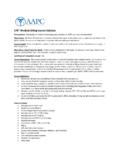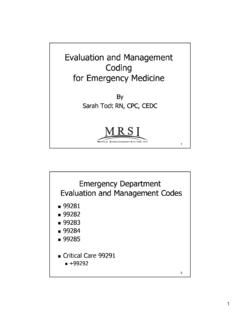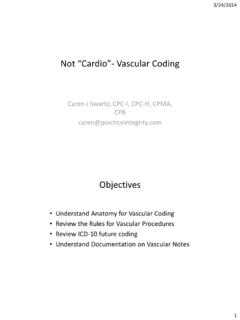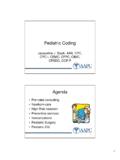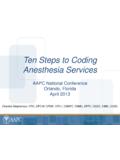Transcription of Coding Dermatology Procedures
1 Coding Dermatology Procedures Presented by: Betty A Hovey Director, ICD-10 Development and Training AAPC 1 No part of this presentation may be reproduced or transmitted in any form or by any means (graphically, electronically, or mechanically, including photocopying, recording, or taping) without the expressed written permission of AAPC. 2 CPT copyright 2012 American Medical Association. All rights reserved. Fee schedules, relative value units, conversion factors and/or related components are not assigned by the AMA, are not part of CPT, and the AMA is not recommending their use. The AMA is not recommending their use.
2 The AMA does not directly or indirectly practice medicine or dispense medical services. The AMA assumes no liability for data contained or not contained herein. CPT is a registered trademark of the American Medical Association. The responsibility for the content of any National Correct Coding Policy included in this product is with the Centers for Medicare and Medicaid Services and no endorsement by the AMA is intended or should be implied. The AMA disclaims responsibility for any consequences or liability attributable to or related to any use, nonuse or interpretation of information contained in this product.
3 3 Anatomy Shaving of Lesions Excision of Lesions Repairs Adjacent Tissue Transfer Destruction of Lesions Mohs Micrographic Surgery AGENDA 4 5 While skin cancers can be found on any part of the body most (about 80%) appear on the face, head, or neck The primary cause of skin cancer is ultraviolet radiation -most often from the sun Also from artificial sources like sunlamps and tanning booths Skin Cancer 6 BCC Basal cell carcinoma is the most common form of skin cancer, affecting 800,000 Americans each year The most common of all cancers 1 out of every 3 new cancers is a skin cancer Most are basal cell carcinomas (BCC)
4 These cancers arise in the basal cells, which are at the bottom of the epidermis More common in men, although more women are getting BCCs than in the past Skin Cancer 7 Warning Signs of BCC sore that bleeds, oozes, or crusts and remains open for three or more weeks reddish patch or irritated area, frequently occurring on the chest, shoulders, arms, or legs bump, or nodule, that is pearly or translucent and is often pink, red, or white Skin Cancer 8 Warning Signs of BCC growth with a slightly elevated rolled border and a crusted indentation in the center area which is white, yellow or waxy, and often has poorly defined borders Skin Cancer 9 SCC Squamous cell carcinoma (SCC)
5 , the second most common skin cancer after basal cell carcinoma Afflicts more than 200,000 Americans each year Arises from the epidermis and resembles the squamous cells that comprise most of the upper layers of skin SCCs may occur on all areas of the body but are most common in areas exposed to the sun Skin Cancer 10 Warning Signs of SCC wart-like growth that crusts and occasionally bleeds persistent, scaly red patch with irregular borders that sometimes crusts or bleeds open sore that bleeds and crusts and persists for weeks 4. An elevated growth with a central depression that occasionally bleeds.
6 A growth of this type may rapidly increase in size Skin Cancer 11 Melanoma Most serious form of skin cancer If diagnosed and removed early it is almost 100% curable Once it metastasizes (spreads) to other parts of the body, it is hard to treat and can be deadly Number of cases has increased more rapidly than any other cancer over the past 10 years Over 51,000 new cases are reported to the American Cancer Society each year Skin Cancer 12 Skin Cancer Benign vs. Malignant Symmetrical Asymmetrical 1A 1B Even Borders Uneven Borders 2A 2B One Shade Two/More Shades 3A 3B Small than Larger than 4A 4B 13 ICD-9-CM Coding Chapter 2 of the ICD-9-CM contains the codes for most benign and all malignant neoplasms.
7 Certain benign neoplasms, such as prostatic adenomas, may be found in the specific body system chapters. To properly code a neoplasm it is necessary to determine from the record if the neoplasm is benign, in-situ, malignant, or of uncertain histologic behavior. If malignant, any secondary (metastatic) sites should also be determined. Skin Cancer 14 Do not go to the Neoplasm Table first Reference histological term first, if given Melanoma a good example of when going directly to the Table is not a good idea Skin Cancer 15 Primary malignancy previously excised When a primary malignancy has been previously excised or eradicated from its site and there is no further treatment directed to that site and there is no evidence of any existing primary malignancy, a code from category V10, Personal history of malignant neoplasm, should be used to indicate the former site of the malignancy.
8 Any mention of extension, invasion, or metastasis to another site is coded as a secondary malignant neoplasm to that site. The secondary site may be the principal or first-listed with the V10 code used as a secondary code. Skin Cancer 16 Topical Medications Curettage and Electrodessication Excisional Surgery Radiation Mohs Micrographic Surgery Cryosurgery Laser Surgery Photodynamic Therapy (PDT) TREATMENT OPTIONS 17 CPT Definition Shaving is the sharp removal by transverse incision or horizontal slicing to remove epidermal and dermal lesions without a full-thickness dermal excision. This includes local anesthesia, chemical or electrocauterization of the wound.
9 The wound does not require suture closure. Shave 18 11300 Shaving of epidermal or dermal lesion, single lesion, trunk, arms or legs; lesion diameter cm or less 11305 Shaving of epidermal or dermal lesion, single lesion, scalp, neck, hands, feet, genitalia; lesion diameter cm or less 11310 Shaving of epidermal or dermal lesion, single lesion, face, eyelids, nose, lips, mucous membrane; lesion diameter cm or less 11301 lesion diameter cm to cm 11306 lesion diameter cm to cm 11311 lesion diameter cm to cm 11302 lesion diameter cm to cm 11307 lesion diameter cm to cm 11312 lesion diameter cm to cm 11303 lesion diameter over cm 11308 lesion diameter over cm 11313 lesion diameter over cm The dermatologist shaved three epidermal lesions that the patient chose not to have submitted to pathology: a cm lesion from the patient s chest, a cm lesion from the patient s back, and a cm lesion from the patient s forehead.
10 11310, 11300, 11300-59 (modifier 51 may be needed depending on payer) Example 20 CPT Definition Excision is defined as full-thickness (through the dermis) removal of lesion, including margins, and includes simple (non-layered) closure when performed Deeper than a shave (partial thickness) Excision 21 Code selection is determined by measuring the greatest clinical diameter of the apparent lesion plus that margin required for complete excision (lesion diameter plus the most narrow margins required equals the excised diameter). The margins refer to the most narrow margin required to adequately excise the lesion, based on individual judgment.
